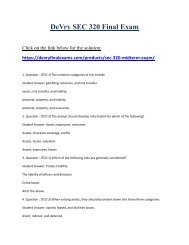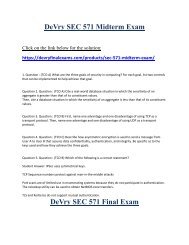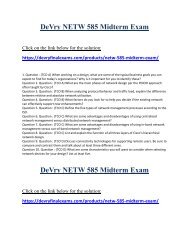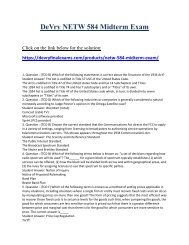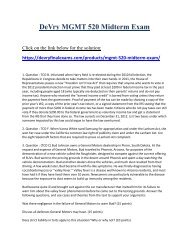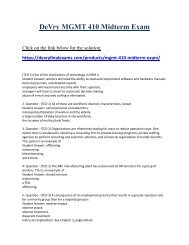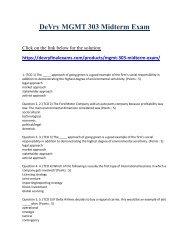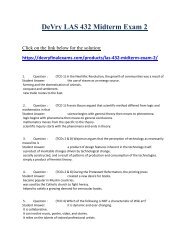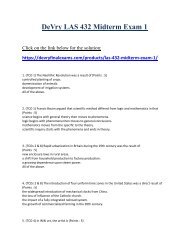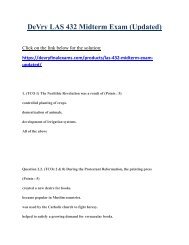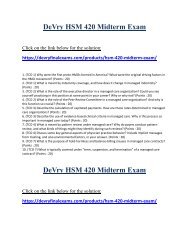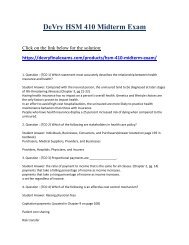HSM 340 Midterm Exam
Create successful ePaper yourself
Turn your PDF publications into a flip-book with our unique Google optimized e-Paper software.
DeVry <strong>HSM</strong> <strong>340</strong> <strong>Midterm</strong> <strong>Exam</strong><br />
Click on the link below for the solution:<br />
https://devryfinalexams.com/products/hsm-<strong>340</strong>-midterm-exam/<br />
1. Question : (TCO 4) Which of the following is part of a statistics budget?<br />
Student Answer: Output expectations<br />
Responsibility for estimation<br />
Estimation methodology<br />
All of the above<br />
2. Question : (TCO 4) The following is an example of a _____________ budget:<br />
“The budget for the radiology department is different at 90 percent occupancy than at 80 percent<br />
occupancy.”<br />
Student Answer: rolling<br />
flexible<br />
forecast<br />
fixed<br />
3. Question : (TCO 4) Effectiveness is a relationship between:<br />
Student Answer: Outputs and organizational goals<br />
Inputs and outputs<br />
Inputs and organizational goals<br />
None of the above.<br />
4. Question : (TCO 3) What is the main reason that relative value units (RVUs) often are used in health<br />
care?<br />
Student Answer: Not all standard units show up in a standard treatment protocol.<br />
RVUs enable more accurate pricing.<br />
RVUs are the optimal way to estimate the costs of the resources consumed by cost objects such as<br />
products and customers.<br />
Some departments or cost centers may have large numbers of outputs, which make individual costing<br />
very time consuming and expensive.<br />
5. Question : (TCO 3) Your controller has told you that the marginal profit of DRG 209 (major joint<br />
procedure) for a Medicare patient exceeds the marginal profit for an average charge patient. Why might<br />
this occur?<br />
Student Answer: High fixed costs of treatment<br />
Low Medicare payment<br />
High prices<br />
Low prices<br />
6. Question : (TCO 2) The heading of every financial statement should contain the:<br />
Student Answer: name, title, and place of business<br />
name, title, and specific date of statement<br />
title, name, type of ownership, and unit of measurement
title of statement, name of entity, and unit of measurement<br />
name, title, specific date of statement, and unit of measurement<br />
7. Question : (TCO 2) Which of the following is the BEST example of a financial metric?<br />
Student Answer: Degree of innovation<br />
Employee empowerment<br />
Accreditation by the Joint Commission on Accreditation of Healthcare Organizations<br />
Total margin<br />
Length of stay<br />
1. Question : (TCO 4) Formulate your answer based on the below information. Costs per case increased<br />
to $4,900 from a budgeted value of $4,750. This increased actual total costs by what amount?<br />
You have been asked by management to explain the variances in costs under your inpatient capitated<br />
contract. The following data is provided. Use the following data to calculate the variances.<br />
Budget Actual<br />
Inpatient Costs $12,568,500 $16,618,350<br />
Members 42,000 42,000<br />
Admission Rate 0.070 0.095<br />
Case Mix Index 0.90 0.85<br />
Cost per Case (CMI = 1.0) $4,750 $4,900<br />
2. Question : (TCO 4)Based on the information below, assume that the only change in the original<br />
example data is that Blue Cross raises their discount to 20 percent. What price should be set?<br />
You have been asked to establish a pricing structure for radiology on a per-procedure basis. Present<br />
budgetary data is presented below:<br />
Budgeted Procedures $10,000<br />
Budgeted Cost $400,000<br />
Desired Profit $80,000<br />
It is estimated that Medicare patients comprise 40 percent of total radiology volume and will pay on<br />
average $38.00 per procedure. Approximately 10 percent of the patients are cost payers. The remaining<br />
charge payers are summarized below:<br />
Payer Volume% Discount%<br />
Blue Cross 20 4<br />
Unity PPO 15 10<br />
Kaiser 10 10<br />
Self Pay 5 40<br />
50%<br />
3. Question : (TCO 4) What is the amount of variance that can be attributed to the difference between<br />
budgeted and actual volume?<br />
Use the following data to calculate the variances.<br />
The following information has been prepared for a home health agency.<br />
Budget Actual<br />
Wage Rate per Hour $16.00 $17.00<br />
Fixed Hours 320 320<br />
Variable Hours per Relative<br />
Value Unit (RVU) 1.0 1.1<br />
Relative Value Units (RVUs) 1,000 1,200<br />
Total Labor Hours 1,320 1,640<br />
Labor Costs $21,120 $27,880<br />
Cost per RVU $21.12 $23.23
Budgeted costs at actual volume would be $25,344 ($21.12 × 1,200), and the total variance to be<br />
explained is $2,536 Unfavorable ($27,880 – $25,344). Be sure to specify whether the variance is<br />
favorable or unfavorable.<br />
4. Question : (TCO 2) Explain the difference between the accrual basis of accounting and the cash basis<br />
of accounting.?<br />
5. Question : (TCO 2) What is an audit (in the context of financial accounting)?<br />
6. Question : (TCO 1) What are social responsibility and ethics as they relate to business-oriented<br />
organizations? How should social responsibility and ethics affect the decisions of even for-profit<br />
companies?<br />
7. Question : (TCO 2) Define and describe the purpose of fund accounting (now called net assets).<br />
DeVry <strong>HSM</strong> <strong>340</strong> <strong>Midterm</strong> <strong>Exam</strong><br />
Click on the link below for the solution:<br />
https://devryfinalexams.com/products/hsm-<strong>340</strong>-midterm-exam/



